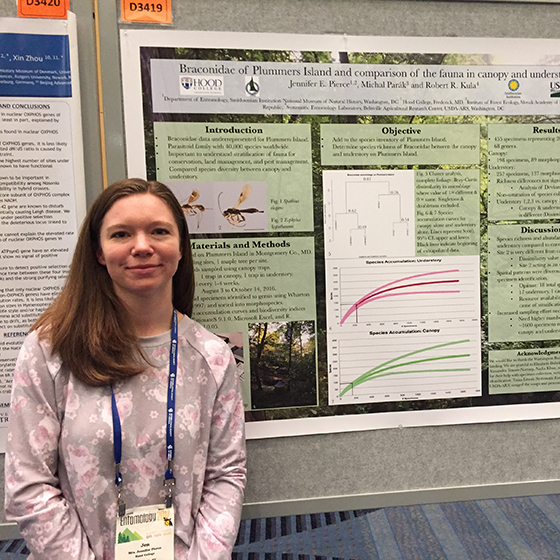Hood Graduate Student Presents Research at ESA and ECN Conferences

Alumna Jennifer Erin Pierce published her research on Plummers Island in the Potomac River.
Jennifer Pierce
Graduation Year
2017
Program
- Environmental Biology (M.S.)
Department
- Biology
Jennifer Erin Pierce, a 2017 graduate of Hood College’s M.S. in Environmental Biology, recently published research she has been working on as a part of her internship with the Smithsonian National Museum of Natural History (NMNH). “Braconidae of Plummers Island and Comparison of the Fauna in Canopy and Understory”, was presented at this year’s Entomological Society of America (ESA) Conference and the Entomological Collections Network (ECN), both in Denver, Colorado.
Plummers Island is a 12-acre Potomac River island in Montgomery County, Maryland, about nine miles upriver from Washington, D.C., and is the most scientifically studied island in North America. The goal of the study was to determine species richness between the canopy and understory of Braconidae, important parasitoid wasps used for biocontrol, in eastern deciduous forests, and to understand if stratification occurs.
“My job was to chemically dehydrate the specimens, point mount them, label them, and then identify all of the Braconids to their genus and then separate them into their different species,” said Pierce
She is currently working on naming the specimens, which can be difficult because not all genera have species keys. Once the species were separated, Pierce and her team found out that they would need around 1600 specimens from the canopy and the understory individually before they reached species saturation, indicating that there are potentially a lot more species to be found on Plummers Island. They also found that species richness and abundance is higher for the understory compared to the canopy. She is hoping to get back to Plummers Island this summer for more sampling.
Pierce was assisted in her research by Dr. Bob Kula, a research entomologist for the USDA Systematic Entomology Laboratory in Beltsville, Maryland. She has only words of praise for her mentor. “He's been a great mentor for this project and has encouraged me every step of the way.” Pierce was also assisted by Dr. Michal Parak, a researcher at the Institute of Forest Ecology in Slovakia who helped with the statistics on the project and often collaborates with Dr. Kula.
Pierce's Hood experience provided the background knowledge needed for this project. "A lot of the courses I've taken for this program are ecology-based, which has helped me understand why stratification of Braconidae could be occurring on Plummers." Pierce also gained writing skills through her course work, which has been a big help, along with the interpretation of statistical results. She mentioned in particular Dr. April Boulton's Insect Ecology course, which provided helpful background knowledge on the subject.
According to Pierce, among the essential things for a student is to go out there and make contacts. "I've learned that networking is an important part of research because scientists are always collaborating with one another. Whether it's through internships or volunteering, go out there and meet some scientists!"
Are you ready to say Hello?
Choose a Pathway
Information will vary based on program level. Select a path to find the information you're looking for!
